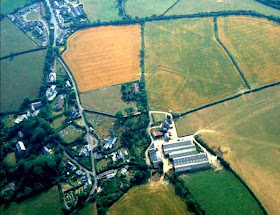Today, Paqui has started explaining that we have some links in the blogger to review for the exam. We also remembered what we have studied the last day. She showed us a graphic about Demographic Revolution and she said that now we have the similar situation ( low birth rates and low mortality rates ) and population growing is very slow and we loss population, because people go to other countries and we need young people. She also said: "that the prime minister say that to solve the solution is to die".
Then we saw an other graphic about Life Expectancy, it was very low until 18 century but then it increase considerably. An example of Life Expectancy, in Africa is around 40 years old, the average.
After we have seen the point about Agricultural Revolution: The reason was that it were more demands of products and farmers started to produce more. The many improvements were:
- Extension of the cultivated lands.
Enclosures: many communal lands, were sized by private farmers, enclosed and converted in private lands.The consequences was that more lands were cultivated.
- Improvements in stockbreeding.
Charles Turnip Thownsed introduced a system called:
Four- field system of crop rotation ( Norfolk system ). Alternation of cereals and fooder crops. This way the farmers:
- got cereals
- got food for the cattle
- got natural fertilizers for the land
- could renew the land without leaving any part follow.
The crops cultivated in this system were: turnips, ryegrass and clover for animals and wheat, baley for people.
- Inventions and innovations.
Some invention made the mechanization of some works possible.
- Seed Drill ( invented by Jethro Tull ).
- Rotherham Iron Plough ( invented by Joseph Foljambe ).
- Threshimg Machine ( invented by Andrew Meikle ).
Glossary
statement-declaración enclosures-cercamiento de tierras
Estate-Estamento fallow-barbeche
useless-inútil manure-estiercol
in good mood-en buena forma fodder-foraje
average-medio turnip-nabo
to feed-alimentar ryegrass-césped
cattle-ganado clover-trébol
to saize-ocupar to graze-tierras comunales
Finally for homework we have to do a summarize of the Agricultural Revolution ( pag.23 ) including the causes, the improvements and innovations and the consequences.
STUDY FOR THE EXAM!!
Bye...



Hello Andrea,
ReplyDeleteI´ll check the mistakes tomorrow. I think the pictures you´ve included are very interesting, but you have to write their sources.
Good night!
Hello! I have read your journal and I like the photos you have included. These are the mistakes I have found:
ReplyDelete- on the blog.
- what we studied
- has showed
- has said
- population growth
- She has also said
- that a Japanesse minister said that elder people have to hurry up and and die.
- we have seen another...
- it increased considerably.
- For example, the life expentancy's average in Africa is around 40 years old.
- was that there were
Hello,
ReplyDeleteRoxana´s corrections are all OK. This is what she didn´t find:
- Word order: Some links to review for the exam on the blog
- We havealso remembered
-... a graph
- ... are losing population
- ... we have seen another graph
-... it increased
-... there was more demand for
- the main improvements...
- communal lands were seized... The consequence....
- Spelling mistakes: fodder,
fallow, barley, inventions, threshing, seize
-... do a summary
- Spelling mistakes in Spanish: barcbecho, estiércol, forraje
- To graze means "pastar". "Tierras comunales" is commons
Please, correct all this quickly. See you!